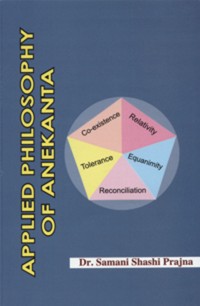The saptabhaṅgī (the theory of seven-fold predication) is a method of cognition to apprehend the correct nature of Reality through a sevenfold relative dialectic method. It is treated as complementary to the syādvāda doctrine. Akalaṁka thinks of it as a way, which considers the modes of a thing in positive (vidhimukhena) and negative (niṣedhamukhena) manner without incompatibility in a certain context. In these propositions affirmation, negation, and such other alternatives define the nature of the Reality. This can be demonstrated by the doctrine of seven fold predication (saptabhaṅgī) which is as follows[1]:
- The X certainly (eva) exists in some respect (syāt).
- The X certainly (eva) does not exist in some respect (syāt).
- The X certainly (eva) exists and does not exist in some respect (syāt).
- The X is certainly (eva) indescribable in some respect.
- The X certainly (eva) exists and is indescribable in some respect (syāt).
- The X certainly (eva) does not exist and is indescribable in some respect (syāt).
- The X certainly (eva) exists, certainly does not exist and is indescribable in some respect (syāt).
The first avayava (standpoint) means that X exists from the viewpoint of its ‘own nature’. X exists as X. The second means that X does not exist from the viewpoint of ‘foreign nature’. X does not exist as other than X. The third predicates of X, both existence and non-existence in succession. This avayava is a compound of the first and the second. It is not simple and primary. The fourth means that both existence and non-existence cannot be predicated of X simultaneously, due to that the limitation of language. But it does not mean that they are not present in X simultaneously. The fifth is a compound one combining the first and the fourth, the sixth is a compound one combining the second and the fourth, and the seventh is a compound one combining the first, the second and the fourth. These seven avayavas exhaust all the mathematical possibilities with regard to one character.
The expression 'certainly' (eva) in the above propositions indicates the definite character of the assertion or the negation or indescribability or their possible combinations.[2] Sometimes it is suggested that the expression 'also' (api) should be substituted for the intended attributes (existence, non-existence, etc.) would not be definitely determined. In the absence of relativism indicated by the phrase 'in some respect' (syāt), the use of the expression 'eva' (certainly) would confer an absolutistic import on the propositions. But by the use of the word 'syāt' (in some respect) indicative of relativism, the expression 'certainly' (eva) loses the absolutistic import and confirms definiteness on the intended attributed predicate in the propositions. For this reason, Ācārya Samantabhadra says that the word 'syāt' is a symbol of truth.[3] And therefore, the Jain Ācāryā-s say that in some cases of predications, even if the term, the 'syāt' is not used, it is to be considered as implicit in the predication.[4]
Syādvāda is the expression of the pictures of Reality obtained from different points of view in definite and determinate logical predications. It expresses a protest against one-sided, narrow, dogmatic and fanatical approach to the problem of reality. It presents a comprehensive and a synoptic picture of reality with particular points of view, of the different characteristics like the permanence and impermanence, similarity and difference, explicabie and inexplicabie, Reality and appearance.[5]Thus syādvāda is the expression of the anekāntavāda in logical and predicational form.[6]
 Dr. Samani Shashi Pragya
Dr. Samani Shashi Pragya

